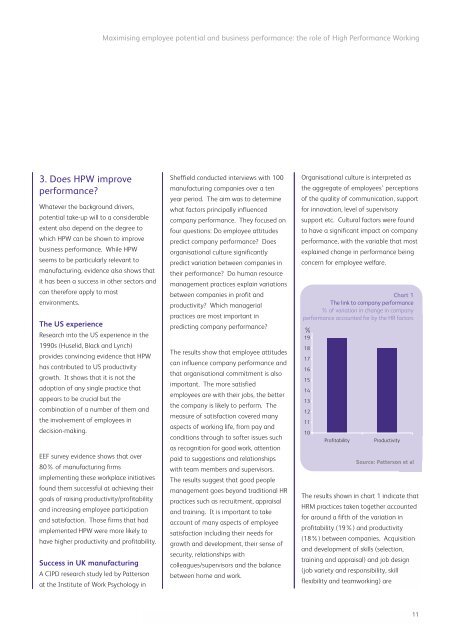About EEF - CIPD
About EEF - CIPD
About EEF - CIPD
Create successful ePaper yourself
Turn your PDF publications into a flip-book with our unique Google optimized e-Paper software.
Maximising employee potential and business performance: the role of High Performance Working3. Does HPW improveperformance?Whatever the background drivers,potential take-up will to a considerableextent also depend on the degree towhich HPW can be shown to improvebusiness performance. While HPWseems to be particularly relevant tomanufacturing, evidence also shows thatit has been a success in other sectors andcan therefore apply to mostenvironments.The US experienceResearch into the US experience in the1990s (Huselid, Black and Lynch)provides convincing evidence that HPWhas contributed to US productivitygrowth. It shows that it is not theadoption of any single practice thatappears to be crucial but thecombination of a number of them andthe involvement of employees indecision-making.<strong>EEF</strong> survey evidence shows that over80% of manufacturing firmsimplementing these workplace initiativesfound them successful at achieving theirgoals of raising productivity/profitabilityand increasing employee participationand satisfaction. Those firms that hadimplemented HPW were more likely tohave higher productivity and profitability.Success in UK manufacturingA <strong>CIPD</strong> research study led by Pattersonat the Institute of Work Psychology inSheffield conducted interviews with 100manufacturing companies over a tenyear period. The aim was to determinewhat factors principally influencedcompany performance. They focused onfour questions: Do employee attitudespredict company performance? Doesorganisational culture significantlypredict variation between companies intheir performance? Do human resourcemanagement practices explain variationsbetween companies in profit andproductivity? Which managerialpractices are most important inpredicting company performance?The results show that employee attitudescan influence company performance andthat organisational commitment is alsoimportant. The more satisfiedemployees are with their jobs, the betterthe company is likely to perform. Themeasure of satisfaction covered manyaspects of working life, from pay andconditions through to softer issues suchas recognition for good work, attentionpaid to suggestions and relationshipswith team members and supervisors.The results suggest that good peoplemanagement goes beyond traditional HRpractices such as recruitment, appraisaland training. It is important to takeaccount of many aspects of employeesatisfaction including their needs forgrowth and development, their sense ofsecurity, relationships withcolleagues/supervisors and the balancebetween home and work.Organisational culture is interpreted asthe aggregate of employees’ perceptionsof the quality of communication, supportfor innovation, level of supervisorysupport etc. Cultural factors were foundto have a significant impact on companyperformance, with the variable that mostexplained change in performance beingconcern for employee welfare.Chart 1The link to company performance% of variation in change in companyperformance accounted for by the HR factors%19181716151413121110ProfitabilityProductivitySource: Patterson et alThe results shown in chart 1 indicate thatHRM practices taken together accountedfor around a fifth of the variation inprofitability (19%) and productivity(18%) between companies. Acquisitionand development of skills (selection,training and appraisal) and job design(job variety and responsibility, skillflexibility and teamworking) are11
















